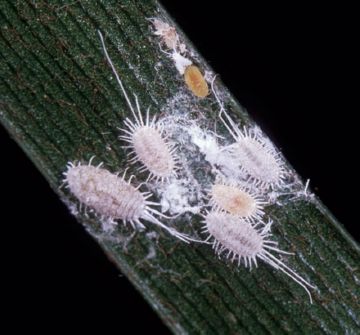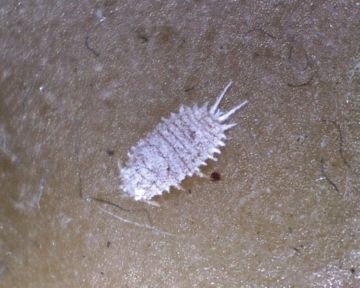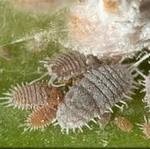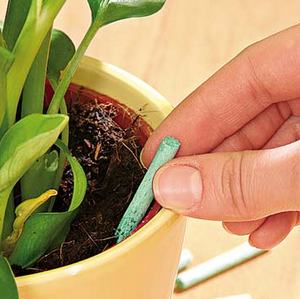Flip on the leaves. Mute Cherver on Fir
Mathematical worms refer to sucking insects. They are sulled to the leaves and buds of home plants and suck their juice. The size of the insect is small - only 5 mm, there are smaller varieties.
 The pest is difficult to confuse with others
The pest is difficult to confuse with others He has an oval body, pubes with Villages around the edges. Have a white or cream color. The males differ from the females pronounced parts of the body: the head, the abdomen and the breast they are clearly visible.
The female is also more like a larva, her body has a solid oval shape, head and other parts are not visualized.
In the process of its livelihood forming sugar dischargewhich can develop a sage mushroom.
Insects can be detect on leaves - Localizes in shoots, fruits, strings. Such a juice, inject your saliva in it.
Enzymes that are in it adversely affect the flower condition, deteriorates the metabolism.
As a result, the leaves begged. If you do not accept any measures, the pet will die sooner or later.
 The plant affected by Chervets loses foliage
The plant affected by Chervets loses foliage Why come on indoor plants
Favorable medium for pest appearance is:
- over dry air;
- application of infected soil;
- excess nitrogen fertilizers;
- lack of hygienic procedures.
An infected copy begins to stick and lose the leaves, it acquires an oppressed look. With careful inspection, it is possible to detect small white fluffy lumps on the leaves.
How to deal with pest
Before dealing with harmful insects, infected flower should be isolated from the rest. Cherweans can move to neighboring flowers, so they should be inspected regularly.
The affected places are treated with a soap solution in which woven cotton tampon. All the affected areas should be thoroughly wipe. If the sheet is badly damaged, it is better to delete it. Alcohol processing is also destructive for insect.
Mathematical worms love dry hot microclimate. Having created such conditions, they can be lured from hard-to-reach places and delete. The males do not feed on the flower, but contribute to the reproduction of pests, so they also need to fight with them.
Male detect more difficultbecause there are in the soil near the flower. For them, traps are satisfied in the form of a sticky ribbon, which is fixed near the light source.
After the leaves and stems were thoroughly washed, treated with insecticides.
For this use poisons in different forms:
- spray;
- sprayers;
- granules;
- sticks;
- oil.
Sprays split from a certain distancenot to damage the pet. Granules are placed in the ground, observing caution to protect the roots.
Oils are applied to damaged areas. Healthy leaves do not need to lubricate, it can disrupt the exchanged process.
Spraying produce in the following drugs:
- Actara;
- Calypso;
- Confident;
- Dance;
- Phytodeterm.
The procedure for using the last we described in detail in the article.
There is I. other efficient drugsTo treat the affected pets.
Before using this or that means, you should read the instructions to avoid harm to the plant.
As an additional fund, you can choose one of folk methods Fight pests:
- handle Affected areas infusion of fragrant tobacco;
- wipe the calendula tincture (can be purchased at the pharmacy);
- processing with garlic infusion (5 teeth cut and pour the floor with liters of boiling water, leave for infusion for 4 hours).
You can use microbiological preparations, In particular - lepyocydom.
Prevention: how to treat white bloom on flowers
To avoid defeat mathematical Cherver, First of all, it is necessary to care for the plant correctly. Even before buying a flower, you need to see well for the presence of insects.
The dry medium favors the development of Chervests, but excessive moisture is harmful to them. It is necessary to fertilize correctly and not allow an excessive feeding with nitrogen fertilizers. Pests love nitrogenous soil.
Correct care will allow to fight in a timely manner and avoid infection. If insects still started, you need to immediately take action. So pests will not spread On adjacent flowers and will not destroy the plant itself.
Mathematical Chervers belong to the family of semi-rigorous and the superfamily of the Chervers, suburbs of Cocid. Cherver is one of the close relatives.
Mathematical Chervests (Latin name pseudococcus) - sucking insects up to 5 millimeters. Chervers belong to the dangerous types of Tly, which destroy mainly greenhouse and indoor plants, but also lively in the wildlife.
The female is illless and has a body of whitish color. In the form of the body closer to oval and elongated, it has grown and on the edges of the bristles. In the insect of milder cherwell there is one pair of wings.
Name
People call these pests with shaggy lies, and "milder" - on whitish silver discharges and on a bloody body, which are similar to flour.
Habitat
Cherver Mucude loves to settle in the sinuses of the leaves, several pieces and dozens of individuals can be chosen by young shoots of juicy plants. If there are serious plants damage to this pest, it can be seen even on the leaves.
Types and role in world fauna
It is known about 2200 species of various Chervestians who have widespread distribution, but still the advantage of species is designated in the tropics. More than 300 species are found in Europe.
Reproduction
The female forms a cluster from highlights, similar to cotton, which are used to lay eggs. At one time, the female can postpone about 2,000 microscopic eggs into cooked fluffy formations, which they traile in the sinuses of the leaves or along the veins. Deferred testicles are protected by volumetric colors and therefore not afraid of water. The grown larvae spread over the entire plant, even the root cervix and roots.
The Chervestians are clearly expressed by sexual dimorphism.
The wings are only in males, strong limbs, abdomen, two tail threads.
Features harm for plants 
The individuals of the milder creeper are capable of separating the liquid of sticky properties (Pad), it is further formed by the so-called sage fungus leading to contamination and disease of the plant.
The main types of muddy wormer:
- bristly;
- grape;
- seaside;
- citrus.
From a bristy cherver
The bristly view of the torrentist Cherwell (Latin name Pseudococcus Longispinus) is a danger in the form of breeding females and voracious larvae.
Mature females body has:
- length up to 3.5 mm;
- oval extended form;
- color pinkish or orange;
- white flag on the body.
Females relate to courtesy species. These insects are well developed limbs due to  with which they without much effort in a short time can move to far plants.
with which they without much effort in a short time can move to far plants.
This species is usually noticeable in the form of clusters on the back of the leaves, on the branches of plants, in the deepening of the sinuses of the leaves and, of course, on young shoots.
A bristly worm is easy to notice on plants for the fact that his body has a clearly sparkling flawflower blooming. The selection of a bristy cherwell also resemble whitish wax lumps.
The leaves that received damage becomes yellow and fall. The shoots have a noticeable lagging in development. It is known that the Cherweans are climed from citrus plants under the bark, and on the bulbous - under the scales of the leaves.
From grape cherweitsa
The grape species of the tormented cherler (Latin name Pseudococcus citri) is a typical pest on grape plants. Oracle also possess developed limbs. 
The body of an adult female has:
- oval expanded form;
- color yellowish or pinky;
- blesley raid resembling powder.
Among the grape worms, males are extremely rare. Larvae, rejected, begin to settle around the plant. Often, strong lesions occur, under which they become a noticeable colony of large sizes, destroying the juicy plants in a short time. The leaves are yellow, shoots dying, falling down.
It feeds not only by various types of beets, it can also cause great damage to oak landings.
Insects can carry very dangerous, and sometimes even fatal diseases. To protect yourself from unpleasant consequences, we advise you to read.
Have you noticed insect eggs on our plants? Then use Ovicidic preparations. How to use these means, you will learn by reference.
From Primorsky Cherweitsa
The body of a mature female has the form oval and elongated, up to 4 mm long, extended to 2.5 mm.  Body color is grayish or pinkish with a grayish mild ripple. Like all Chervests, this species is characterized by developed legs.
Body color is grayish or pinkish with a grayish mild ripple. Like all Chervests, this species is characterized by developed legs.
The males of the seaside worm are the smallest females, have wings. While in the period of the summer. The larvae do not have a wax fly on the body. As usual, the larvae spread over the plant, they are spreading to neighboring growing plants. The larva eats constantly, sucks all the useful substances from shoots and leaves and after a month and a half becomes an adult insect, capable of independently give offspring.
The plants damaged by them cease to bloom, grow and die.
Plants affecting tormentary Cherver:
- all citrus varieties;
- amaryllis, gerbera and azalea;
- cacti, hibiscus;
- lemon and grapes;
- palm trees, monster;
- fuchsia and Asparagus, Kalanchoe;
- camellia, Cissor, Anthurium;
- oleander, Philodendron.
Pest control measures
If the infection of the cherver foliage is not yet explicitly expressed, then the treatment of plants with soapy water will help. Wadded tampons are wetted, and they are treated with leaves, stalks, shoots, roasting sites. To secure the effect, make spraying with a solution of soap, tobacco with influenza, garlic influences, boosters of cyclame plants (calculation of 10 grams per 1 liter of water)
- The larvae feeds continuously, and adult individuals may not even be a mouth.
- Some species of milders are able to distinguish the useful substances that people use in industry (Varnish Cherver and Koshenyle species, giving people a red paint - a substance of carmine).
Mathematical worms - sucking pests of indoor plants, close relatives of the shield. The people are called shaggy lice.
The official name has acquired thanks to whitish wax vessels resembling cotton.
Refer to Pickly insect sub-train Coccid, Family Tough.
Description of insects
MealybugWhat can be seen in the photo - a relatively large insect that can reach 5 mm in length. It has an oval body covered with a white mild ripple and bristles on the sides. Body color can be pink, white or cream. On the back are transverse strips.
This insect is peculiar sexual dimorphism - Large differences between male and female. W. males The head, abdomen, breast and the wings and paws are well visible. W. females The torso is deprived of pronounced departments, it has an oval, slightly extended shape, they look like larvae.
Adults males Very little live, apparently because they do not eat anything. Females are well protected from many chemical preparations With the help of a wax.
A characteristic feature is also fast adaptability To different insecticides.
Reproduction Depending on the species - there are vigorous and egg-standing females. Eggs are put in the front bag, similar to cotton, white color. Chervers are distinguished by strong fertility, giving up to 4 generations per year. First-aged larvae called Broadcasts Because of their ability to actively move on the plant, they are also transferred to the wind.
Mobility disappears After the insect was preserved to the stern plant. Later they linnet, become larvae of the second age and begin to look for a new place of food. Some adult females can also transfer from place to place. Before to postpone eggsMost of the species are hiding in shelter.
Types of Cherverov
More than 1600 knows in the world different specieswhich are found everywhere, but most are concentrated in rainforest. For fans of room flowers, the following types are dangerous:
 Seaside torment Cherver.
Seaside torment Cherver.
The torso of female is a grayish-pink, covered with a raid, has a form of oval up to 4mm. Males are much smaller, can fly. Belong to egg-owned species. Little larvae, yellow, the waistly laid is completely absent. The transformation time in an adult person is about 5-6 weeks.
Bristly torment cherry.
Body coloring can be pink and orange, length - 3.5mm. This species has excellent limbs, so they are actively moving on the plant. Vivoric look. Live the colonies on the inside of the sheet, on the stems and young shoots.
 Grape mild cherry.
Grape mild cherry.
The body has a view of a wide oval of pink or yellowish color. The larvae spread over the entire plant.
 Citrus mild cherry.
Citrus mild cherry.
Coloring can be different - from light yellow to brown shade. The females of this species stand out a large number of Sweet secret, which is called Pad. Male - flying individuals, like flies of pink and yellow.
Plants - sacrifices
Most often attacked the following houseplants: Amarillies, gerbera, cacti, citrus, oleander, azaleas, phyladendrons, fuchsia, asparagus, palm trees, Camellia, Monster, Anthurium, Calanete, Orchids, Chlorophytum, Diffenbahia, Hoya.
Cherweets Saw plant juice and injected saliva, in which digestive enzymes are located. These enzymes depress the metabolism. The flower is gradually weakened, starts to lose leaves and can die. In addition, the secretly highlighted in the insect loves a sage fungus.
A characteristic feature of the presence of pest - white wax, reminding cotton in the locations of insects.
Causes of occurrence
If on a flower settlement of mildew CherverIt means that it has already been weakened by improper departure or excess of nitrogen, as a result of which the metabolism was broken. Healthy plants form protective substances that scare the Chervests.
The appearance of insects also promotes Sundered air, which is ideal for their active breeding.
Preventive measures
Treatment from mild custice is better to start with prevention. The reproduction and settlement of insects can prevent the following actions.
Attentive inspection newly acquired plants. It is even better to inspect the flower before buying it.
Immediately remove dried leaves and flowerswhich may be shelter for insects.
Can be used drugs of wood oil them For periodic processing of plants. It is able to get rid of single individuals and small pest groups.
Cherver does not like high temperatures, dilding already at 35 degrees. Therefore, colors from time to time arrange hot shower with water temperatures 40-45 degrees.
Measures to combat torment cherver
how get rid of From the tormentary cherler, if he has already chosen a plant?
First you need place The affected flower in quarantine and carefully examine the remaining flowers. Even if there are no traces of the presence of pests, it is not worth relaxing, repeating inspections within a month.
A plant that has become a victim of the attacks to undergo mechanical cleansing. To do this, wipe the contaminated places with a cotton swab, moistened in warm water or soap solution. Highly affected parts remove. In hard-to-reach places you can use tweezers.
To lure insects, you can place a flower In hot wet conditions. Then they crawl on the surface and they can also delete.
Males Do not sit on the flower, they circle next, without damaging it. However, they need to get rid of them, because many species cannot multiply without male individuals. Anti males use sticky tapes and plates attached next to light sources.
Be sure to be pretty wash The location of the pot with a flower, because part of the pests and their eggs can remain there after the plant was removed.
The next step will be the treatment of the plant drugs From mild cherwell. For this, chemical insecticides are used or folk remedies.
Chemicals
 More sensitive to their action are Lichwoodwhich have not yet been covered with a wax protective layer. To complete the destruction of pests, you need to spend several treatments with a weekly interruption.
More sensitive to their action are Lichwoodwhich have not yet been covered with a wax protective layer. To complete the destruction of pests, you need to spend several treatments with a weekly interruption.
Spraysand Various sprayers Easy to use, spraying chemicals on the plant. Poisonous substances are absorbed into juice, poisoning insects. In order not to damage the flower itself, it should be sprayed from the distance specified in the instructions.
Preparations in the form granulesand Chopsticks It also contains fertilizers, entered into the soil with caution, as they can burn the most gentle roots of some plants.
Funds in its composition oil Applied directly to the affected places. It is impossible to handle large plants of the plant, because the oil, especially paraffin, clogs the pores, not allowing the oxygen to penetrate, and the flower can "suffocate".
All insecticides are divided into three types By action:
Intestinal. The drug penetrates the pest organism through the oral apparatus. These include the vertimepec, Aktellik, Nurell-D, Aktara.
Contact. Chemical falls through skin. It is impossible to put treated plants on the window so that the sunlight does not fall - it is fraught with the yellowing of sheet plates. The most famous are Fosalon and preparations of the German group Sprzit-Aeschadlingsfrei.
System.The poisons fall into the juice of plants and poison insects. These include almost all sprays, such as Rogor and Phosphamide. Insecticides with paration, diazine, molation and dimethion, are the most effective in the fight against mild cherver.
To highly active means affecting large pest colonies include phytodeterm, gold spark, Commander and Aktara.
Folk remedies
Effective can be the fight against milder cherver when used folk methods:
- infusion of fragrant tobacco. It is necessary to spray three times with a weekly interruption.
- green Potash Soap Solution - 15g per liter of water. Treatment three-time.
- tincture of wild chemistry. It is watered and sprayed damaged plants.
- tincture of calendula. It can be bought at the pharmacy and process the flower with a sprayer or cotton swab.
- tincture of garlic. Finely cut 5 pieces of garlic and pour 500ml boiling water. Leave no less than 4 hours, process the plant with a brush, causing infusion on the sheet plates.
- mix soap and alcohol. 10 ml of denatured alcohol mix with 10 ml of liquid soap and stir in a liter of water. Spray the plant through the sprayer.
- olive emulsion. A couple of tablespoons of olive oil stir in a liter of water and apply in any convenient way to flower.
Biological methods of struggle
For this apply insectspowered by mild custody. These include a group of riders, larvae of marmalade flies, cryptolem, ordinary zlatg-treatments.
We wish healthy plants to you!
And for lovers to know everything, we suggest familiarizing yourself with the video that will help you accurately determine the pest.


